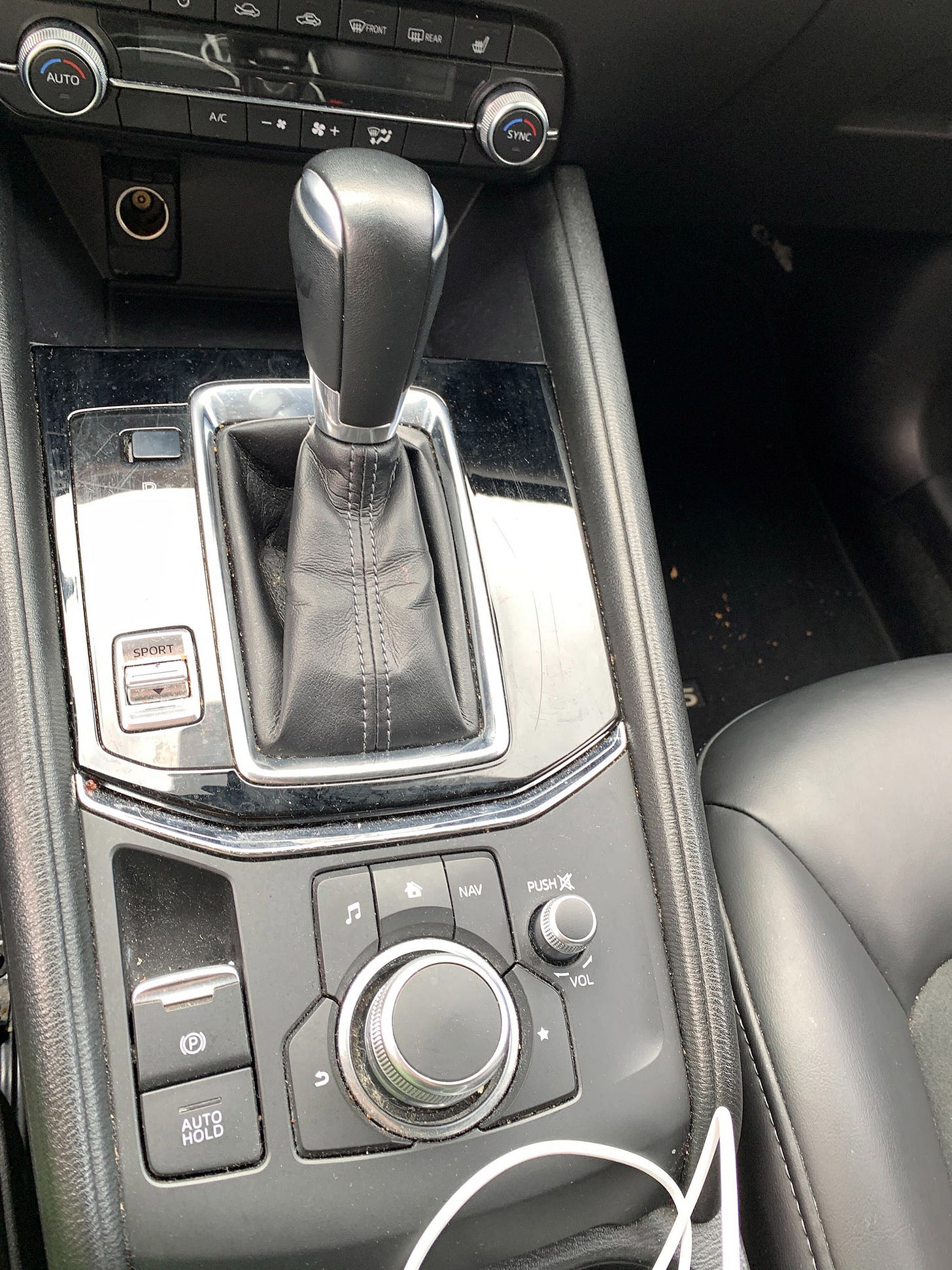Bad Touch
THIS WAS HOW the Mazda dashboard control system introduced itself to me: I was trying to get out of Newark Airport, running Google Maps on my iPhone through the console screen, and I couldn't turn the sound on. I kept jabbing at the logo for the mute/unmute button as I rolled out of the Avis facility, and nothing kept happening, until finally, seemingly at random, the navigation robot voice turned on.
I was already off to a bad start with the car, which was billed as a "Toyota Camry or similar" but was a big stupid "compact SUV," a CX 5. I used to get nimble little Mazda3s from Zipcar before Avis bought Zipcar and ruined it, so when the Avis person had said "Mazda," I'd been mildly optimistic till I saw the thing. But I just wanted to get on the road. There'd been no car reservations available anywhere in Manhattan, and we were bringing the cat along, so the holiday travel plan was for me to get the car at Newark, backtrack to New York to get everyone else, and only then start the Thanksgiving drive for real.
Before the trouble with the mute button, I couldn't even figure out how to turn on the car stereo. I'd stared blankly at the center console, scanning up and down, seeing only the climate controls. At last, in utter confusion, I looked all the way down and back and found the sound system knob under my right elbow, behind the shifter for the automatic transmission.
Now I'd gotten the sound system on and the navigation talking to me, and I was trying to get back to Manhattan as fast as possible. The robot voice piped up to say that I could save five minutes by switching to a different route. Did I want to switch to a different route? I touched the spot on the screen to say yes. It was dead.
Over and over, the robot kept asking me if I wanted to save five minutes. Boy, did I! On Thanksgiving Wednesday, every minute you waste getting out of New York is a minute and a half of road time, or possibly five minutes, because the traffic is just going to keep getting worse all day. But I could not get the robot voice to take yes for an answer. Did I swear at the robot, at the top of my lungs, inside the Mazda? I did.
Eventually, driving at highway speeds, I reached over and unplugged the phone. Then I used the touchscreen on the phone to reset the driving instructions, to get those five minutes back. For the rest of the trip, down and back, I kept unlawfully messing around with my phone to keep it working. Sometimes, instead, I would take my eyes entirely off the road to look down below my right elbow, where along with the audio volume knob, there was some other kind of manual dial, plus push buttons labeled for music, navigation, and home.
Only afterward, when I tried to Google what was going on, did I learn that I had been using a special safety feature. Mazda recently decided to embrace the principle—a principle I endorse, in, um, principle—that touchscreens in cars are unsafe. Replacing individual dashboard knobs and buttons with variable virtual button-emblems on a smooth glass surface was a very foolish idea, the kind of idea that breeds despair about the whole concept of technological progress. Out of a desire to keep up with Steve Jobs' anti-button fetish, as embodied in the iPhone, automotive engineers introduced a technology that requires drivers to turn their full attention away from the road and focus on the dashboard.
Mazda's idea of how to fix this was to keep the touchscreen, with the standard Apple CarPlay touch-interface display unchanged—but to make it impossible to use the touch controls when the car is moving faster than some minimum speed. Instead, the driver is supposed to take a hand off the wheel and reach all the way back to rummage behind the gearshift, using the various physical dials and buttons there to work around the touch commands.
Maybe this makes sense if you own a Mazda, so that you can eventually learn the alternative set of commands by feel. If you're just renting one, though, the system is perverse and impossible. Instead of one thing to take your gaze off the road, now there are two.
NATURAL HISTORY DEP'T.
Addendum
TO FOLLOW UP on August's coverage of how the dread poison ivy and harmless Virginia creeper insist on showing up together, here are photographs of two Granny Smith apple trees growing side by side in a New Jersey orchard. One has the scarlet fall foliage of Virginia creeper climbing its trunk. Its neighbor has the yellow fall foliage of poison ivy.






